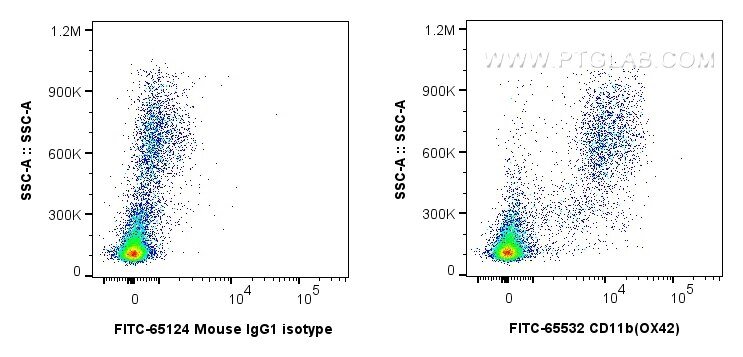CD11b Rekombinanter Antikörper
CD11b Rekombinant Antikörper für FC
Wirt / Isotyp
Maus / IgG1
Getestete Reaktivität
Ratte
Anwendung
FC
Konjugation
FITC Plus Fluorescent Dye
CloneNo.
OX42
Kat-Nr. : FITC-65532
Synonyme
Geprüfte Anwendungen
| Erfolgreiche Detektion in FC | rat bone marrow cells |
Empfohlene Verdünnung
| Anwendung | Verdünnung |
|---|---|
| This reagent has been tested for flow cytometric analysis. It is recommended that this reagent should be titrated in each testing system to obtain optimal results. | |
| Sample-dependent, check data in validation data gallery | |
Produktinformation
FITC-65532 bindet in FC CD11b und zeigt Reaktivität mit Ratten
| Getestete Reaktivität | Ratte |
| Wirt / Isotyp | Maus / IgG1 |
| Klonalität | Rekombinant |
| Typ | Antikörper |
| Immunogen | Rat peritoneal macrophages |
| Vollständiger Name | integrin alpha M |
| Berechnetes Molekulargewicht | 127 kDa |
| GenBank-Zugangsnummer | NM_012711 |
| Gene symbol | CD11b |
| Gene ID (NCBI) | 25021 |
| Konjugation | FITC Plus Fluorescent Dye |
| Excitation/Emission maxima wavelengths | 495 nm / 524 nm |
| Form | Liquid |
| Reinigungsmethode | Affinitätsreinigung |
| Lagerungspuffer | PBS with 0.09% sodium azide |
| Lagerungsbedingungen | Store at 2-8°C. Avoid exposure to light. Stable for one year after shipment. |
Hintergrundinformationen
Integrins are cell adhesion receptors that are heterodimers composed of non-covalently associated α and β subunits (PMID: 9779984). CD11b, also known as Integrin alpha M or CR3A, belongs to the integrin alpha chain family. CD11b forms an α/β heterodimer with CD18 (integrin β2). CD11b/CD18 is implicated in various adhesive interactions of monocytes, macrophages and granulocytes as well as in mediating the uptake of complement-coated particles and pathogens (PMID: 9558116; 20008295). CD11b/CD18 is a receptor for the complement protein fragment iC3b, and is also a receptor for fibrinogen, factor X and ICAM1 (PMID: 2971974; 15485828).
Protokolle
| PRODUKTSPEZIFISCHE PROTOKOLLE | |
|---|---|
| FC protocol for FITC Plus CD11b antibody FITC-65532 | Download protocol |
| STANDARD-PROTOKOLLE | |
|---|---|
| Klicken Sie hier, um unsere Standardprotokolle anzuzeigen |


